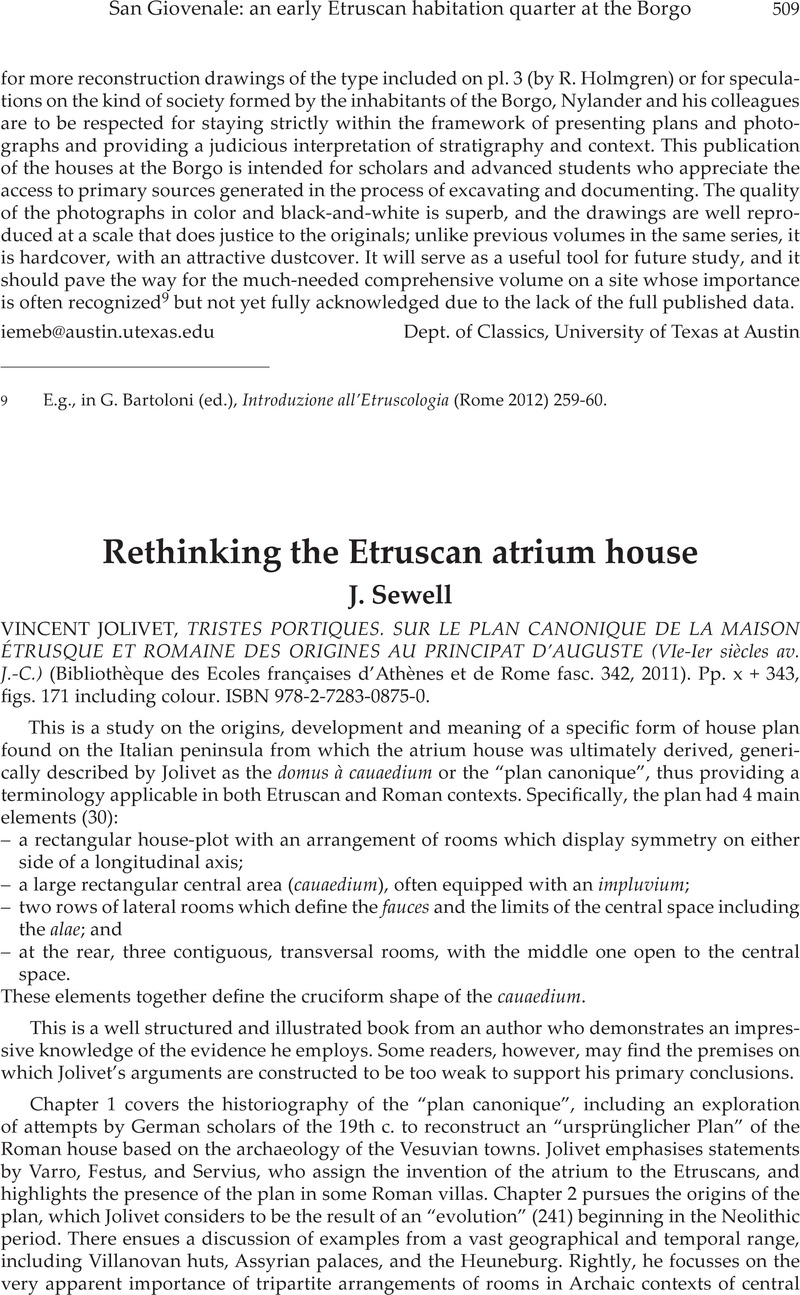No CrossRef data available.
Article contents
Rethinking the Etruscan atrium house - VINCENT JOLIVET, TRISTES PORTIQUES. SUR LE PLAN CANONIQUE DE LA MAISON ÉTRUSQUE ET ROMAINE DES ORIGINES AU PRINCIPAT D'AUGUSTE (VIe-Ier siècles av. J.-C.) (Bibliothèque des Ecoles françaises d’Athènes et de Rome fasc. 342, 2011). Pp. x + 343, figs. 171 including colour. ISBN 978-2-7283-0875-0.
Published online by Cambridge University Press: 27 November 2014
Abstract

- Type
- Reviews
- Information
- Copyright
- Copyright © Journal of Roman Archaeology L.L.C. 2014
References
2 Only the Prato-Gonfienti house, which conforms only partially to the canonical plan, contained finds interpreted as reflecting a high-status occupant: Poggesi, G. et al., “Prato-Gonfienti: un nuovo centro etrusco sulla via per Marzabotto,” in Sassatelli, G. and Govi, E. (edd.), Culti, forma urbana e artigianato a Marzabotto. Nuove prospettive di ricerca (Bologna 2005) at 272 Google Scholar.
3 For the view that the model of the atrium house from the late 4th c. onwards was Roman, see Wallace-Hadrill, A., Rome's cultural revolution (Cambridge 2008) 131 Google Scholar; Sewell, J., The formation of Roman urbanism (338 to c.200 B.C.) (JRA Suppl. 79, 2010) 121–36Google Scholar. Jolivet acknowledges (235) that the majority of Pompeian scholars believe that the Romans were in some way responsible for why the atrium house was widespread at Pompeii, yet he questions this view on the grounds that it does not address why other [less Etruscanized?] centres in Samnium did not adopt it until the end of the Republic. Perhaps this was because the Bay of Naples was distinct from Samnium in terms of urban traditions: the former had urban roots going back to the 8th c., whereas there is little evidence for Graeco-Roman style urbanism establishing itself in Samnium (other than Roman colonies) prior to municipalisation of the 1st c. B.C.
4 Yet he lists 10 examples of the “plan canonique” from Samnium, Apulia and Lucania where an Archaic Etruscan influence is more difficult to prove.
5 The only example he singles out (103-4) as pre-conquest (and not Roman) is the structure at Moltone di Tolve (Lucania), which might have taken on the cauaedium plan around 300 B.C. Yet the Lucanians had already entered a foedus with Rome in 326, supplying troops for Rome's armies (Livy 8.25.3; cf. 9.20). It is after Pompeii is thought to have established a similar relationship with Rome that atrium houses start to appear there. Jolivet cites a statement of N. Terrenato (in JRA 14 [2001] 23) that appears to support his pre-conquest interpretation of Moltone, but it is used out of context since it relates to the economic model of the Catonian villa, not house architecture.
6 Warden, P. G., “The importance of being elite: the archaeology of identity in Etruria (500-200),” in Evans, J. DeRose (ed.), A companion to the archaeology of the Roman Republic (Chichester 2013) 354–86CrossRefGoogle Scholar.


